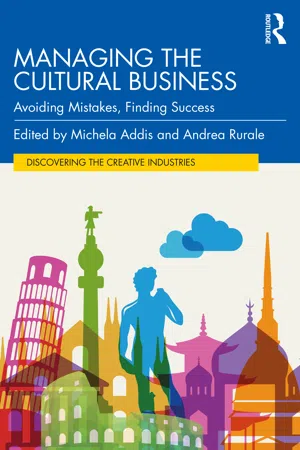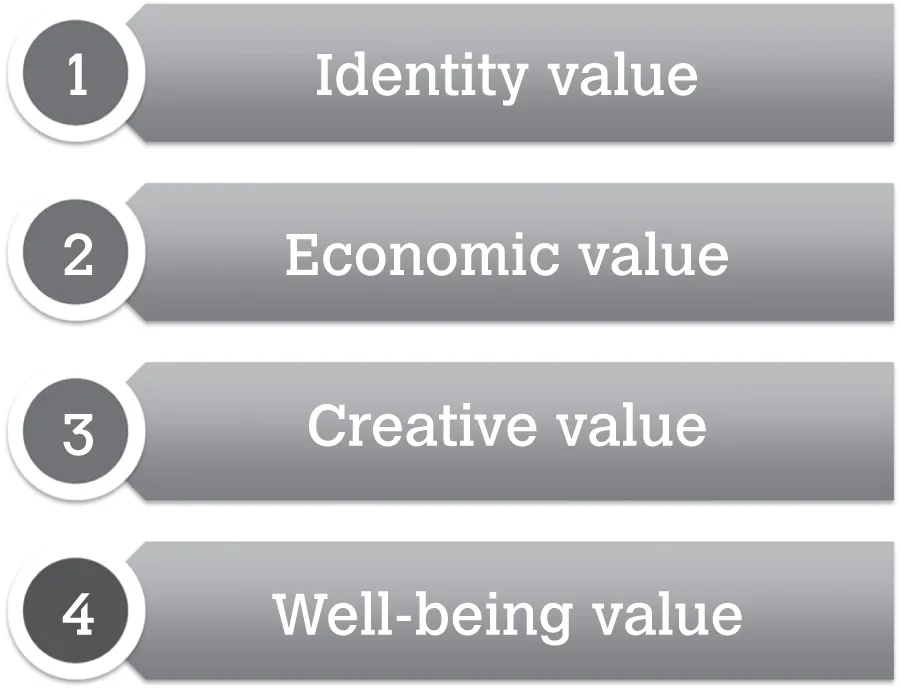
Managing the Cultural Business
Avoiding Mistakes, Finding Success
Michela Addis, Andrea Rurale, Michela Addis, Andrea Rurale
- 386 páginas
- English
- ePUB (apto para móviles)
- Disponible en iOS y Android
Managing the Cultural Business
Avoiding Mistakes, Finding Success
Michela Addis, Andrea Rurale, Michela Addis, Andrea Rurale
Información del libro
The arts and cultural sector has always been a challenging area in which to find business success; the advent of the global health crisis due to COVID-19 has greatly amplified these challenges. Thanks to the expertise of 22 scholars, this text elaborates on the most common key strategic mistakes and misunderstandings to help arts and cultural organizations finding success.
This book starts by looking at the evolution of competition in those industries. Several new and challenging drivers shape the competitive environments of arts and cultural organizations. A customer-centric approach helps in identifying ten crucial managerial processes in which strategic mistakes are commonly made. This book proposes a revised managerial vision of the key processes that constitute every arts and cultural organization. Each chapter offers an innovative analysis of a classic managerial problem, describing popular mistakes and providing case-based insights derived from real world important examples. Specifically, each chapter elaborates on two illuminating examples, one of which is always chosen among the Italian arts and cultural organizations, thus belonging to the world's leading cultural sector.
Speaking to current and student arts managers, this insightful book channels national and supranational cultural heritage to provide essential reading for managers of present and future arts and cultural organizations.
Preguntas frecuentes
Información
A call to revise cultural business management
Chapter 1
Cultural businesses: a matter of value

- The identity value. The first, basic type of value generated by ACOs is what is traditionally labeled the identity value. Culture—in any form, format or way—creates the identity of a population and a territory. Regardless of the specific component of cultural heritage—monuments, protected cultural landscapes, museums and galleries, events, cultural diversity, cultural professionals, cultural infrastructure and organizations, intellectual capital, and cultural excellence—culture is a key driver in territorial development (Espon 2006). It is what binds the citizens of that territory together, what unites them and makes them into a community. Culture then becomes a strategic resource for the long-term sustainable and competitive development of a country (Espon 2006). It is the first basic type of value, and is of interest to both current and future citizens. It can therefore be viewed as an intergenerational value. This is the kind of value that Jean-Claude Juncker, the head of the EU Commission, referred to when he tweeted: “Notre-Dame de Paris appartient à l’humanité toute entière. Quelle triste spectacle. Quelle horreur.”
- The economic value. The second kind of value, which does not replace but adds to the previous one, is the economic value of ACOs. The burning of Notre Dame was considered by some to be a large-scale disgrace due to the economic fallout. As the second-most visited church in the world, with 12 million visitors a year (Statista 2019), its closure has had a significant impact. Calculating an average of 30,000 visitors per day who pay a ticket between €12 and €25, it is easy to calculate the economic damage of the fire.Widening the perspective to take into account the economic dimension of ACOs, the cultural sectors and industries account for some 2.6% of the overall European GDP (European Commission 2010). Additionally, US museums—with more than 850 million visits—have a strong economic impact, since they generate $15.9 billion in income; they also support a large number of jobs, 372,100 jobs directly (a figure that rises to 726,000 when indirect jobs are also included); and in 2016 they contributed $50 billion to the US GDP and $12 billion to US tax revenues (American Alliance of Museums 2017).In more general terms, arts and cultural organizations create a large number of jobs: according to Eurostat data for 2018, culture ...